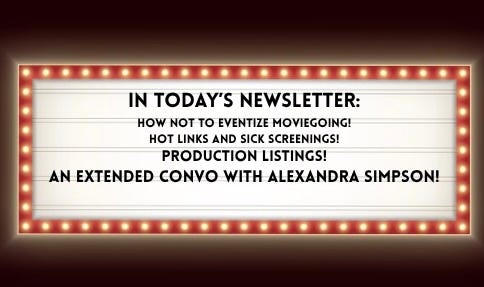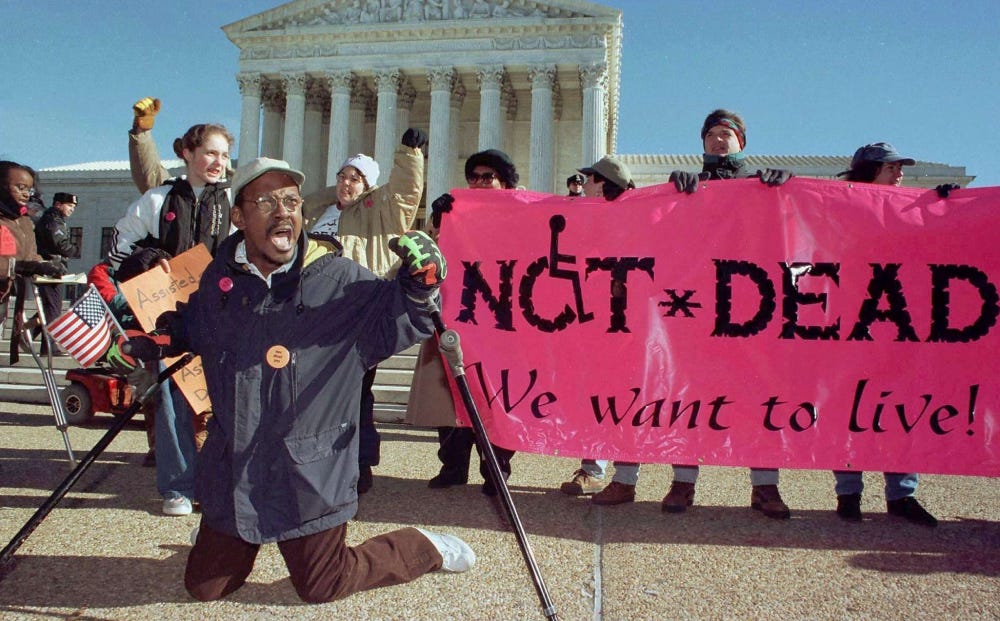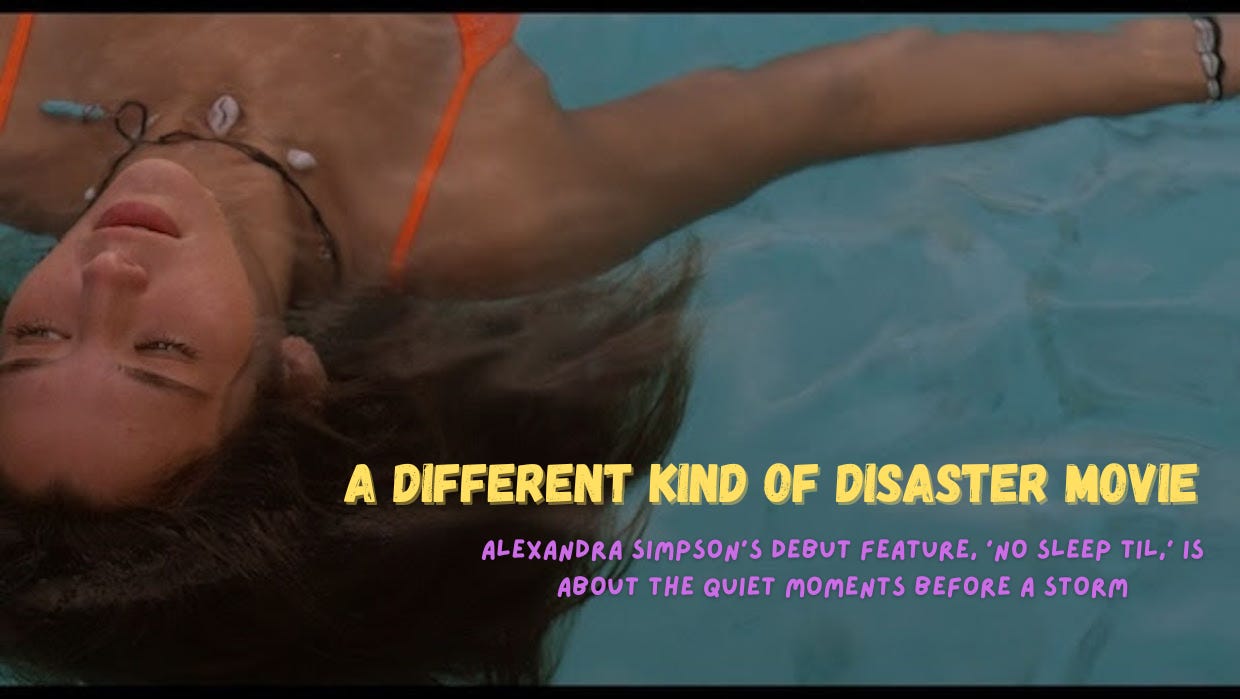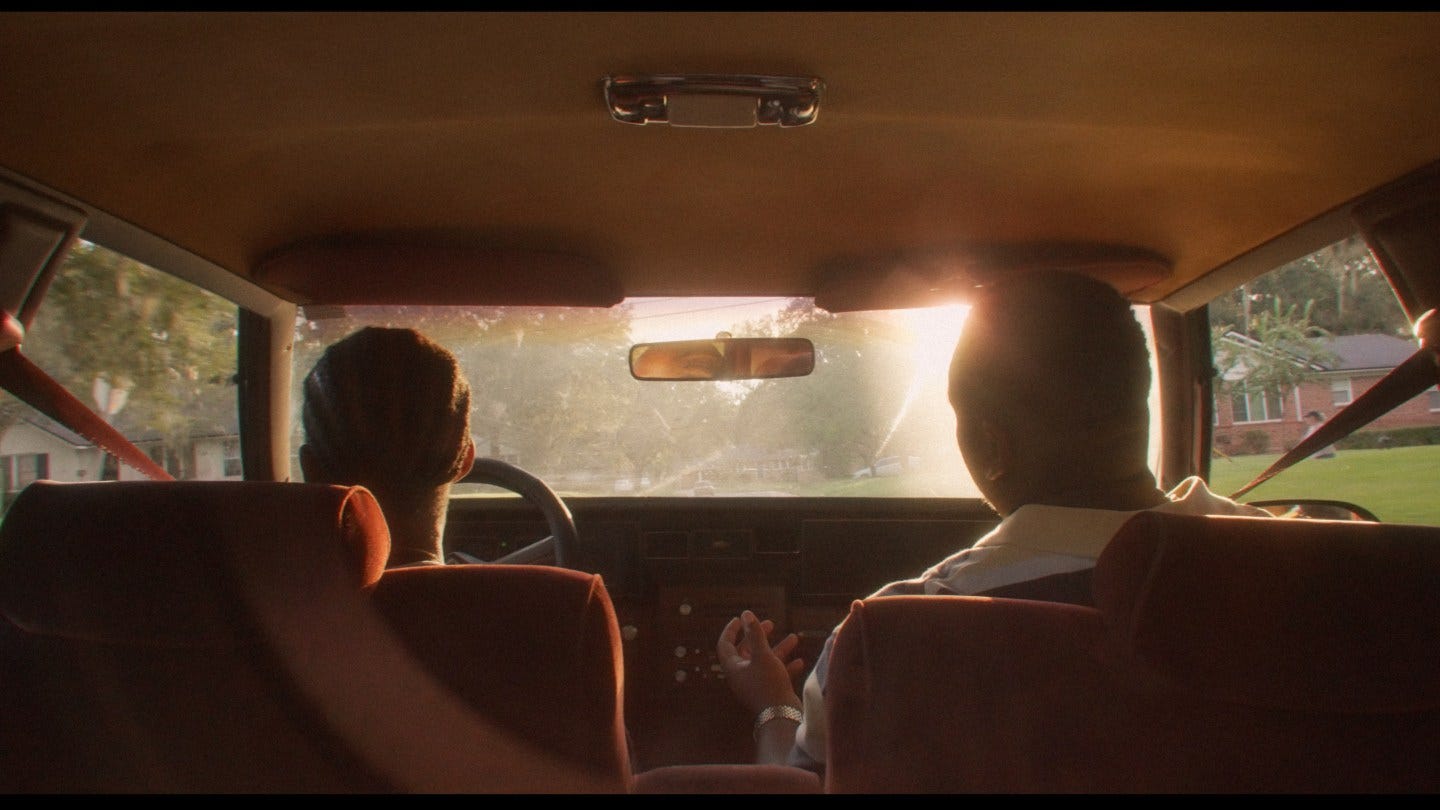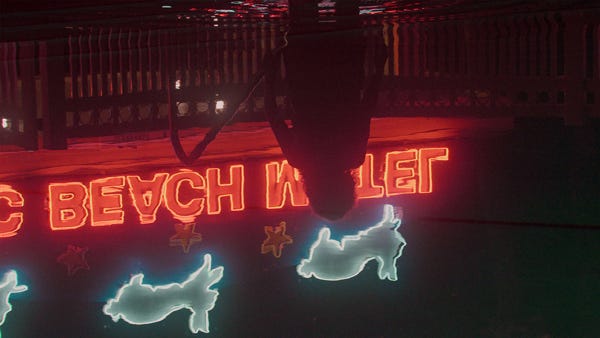A Different Kind of Disaster Movie
Alexandra Simpson’s 'No Sleep Till' is a meditative portrait of a picturesque Florida town on the brink of a natural disaster. We spoke about following intuition and working within a collective.
Good afternoon! A new private theater concept from the founders of Alamo Drafthouse is coming to Manhattan in September. The idea is to give small groups of theatergoers an elevated private experience — gourmet food, vast movie selection, all in a cushy room. They’re pitching it as a way to “eventize” moviegoing. Of course, it’s an event only the rich will comfortably enjoy (the four-person theater will cost $200 for a four-hour booking, food is another $100 per person, and if you want to drink that’ll be another $50 per person).
For years now, I’ve been intrigued by the creative ways theaters, distributors, and filmmakers have tried to make moviegoing into a special event. In the best cases, eventizing can be a means to discovery of obscure or under-appreciated work, a conduit to new personal connections, and, simply, a way to make the whole experience of catching a flick more fun. This though? It ain’t it. Metro Private Cinema — yes, that’s what it’s called — seems like a novelty attraction that will either quickly fizzle or sustain itself only in the richest pockets of the richest cities. On the one hand, who cares? But on the other, I wish powerful people looking to throw time and money into film would spend it on more populist initiatives. I’ve got a few ideas. If you have millions of dollars and want to experiment, email nothingbogus1@gmail.com. And if you want to talk about better forms of eventizing, sound off in the comments.
HOT LINKS AND SICK SCREENINGS
Things to Read and See
Film Forum’s Kurosawa in 4K series began on Friday runs through the 31st; New York Asian Film Festival runs through July 24 at Lincoln Center; BAM is showing a personal favorite, Jane Campion’s In the Cut on Thursday as part of its NYC 2000s series; this Sunday at Life World, Tone Glow presents "Rotating Signals: The Contemporary Korean Avant-Garde," a program of 10 short films highlighting the current landscape of experimental film in Korea; Kiyoshi Kurosawa’s latest, Cloud, is playing at IFC Center and Film at Lincoln Center; and I plan on getting to Life After at Film Forum this week.
For someone who publishes abajillion newsletters, somehow producer extraordinaire
still manages to be interesting every time he gives an interview. So yeah, I enjoyed reading a recent interview he gave to in Berg’s newsletter, Underexposed. Among the gems, Hope says this of test screenings:We must recognize that if we listen to what people want, it is the equivalent of toddlers wanting candy. The oversimplification of the results contributes significantly to the flattening of culture. There are ways to better understand what they are reacting to. When someone doesn’t “like” a scene or character or element, what they generally mean is that they did not feel prepared for it. It often has more to do with what came before it than the thing itself.
I’ve been thinking about this exact thing as we’ve hosted a couple feedback screenings of The Big Game. There really is almost always a note — or at least a different solution — behind the note.
I have a confession to make: I loved Eddington. Maybe I’ll write about it at some point. But for now, I’ve enjoyed reading/listening to other people’s thoughts on the film. Adam Nayman wrote an interesting, nuanced review of the film and the New Yorker critics had a more critical discussion about it on their podcast.
The feature segment you’re about to read is an interview with No Sleep Till director Alexandra Simpson. Simpson is part of the Omnes Collective. We spoke about Omnes a bit, but if you’re interested in how they operate, check out an interview Simpson and Tyler Taorima gave on the Indiewire Toolkit podcast. The Omnes peeps have figured some things out regarding working together to make small budget indie filmmaking more sustainable, and I found it to be a pretty inspiring conversation.
For a deep dive into another Omnes filmmaker’s debut, read my interview with Eephus writer-director Carson Lund.
THE FEATURE ATTRACTION
A Different Kind of Disaster Movie
Alexandra Simpson’s first feature, No Sleep Till, is a meditative portrait of a picturesque Florida town on the brink of a natural disaster. We spoke about following intuition, letting sound guide the way, and working within a collective.
Alexandra Simpson grew up in France. But her family would spend summers in Atlantic Beach, Florida, a small, picturesque vacation town on Florida’s northeast coast, where her father grew up. “It's been a place that I've had a very strange association to,” Simpson says. “One that's very much imbued with nostalgia because we would only go there in the summertime, and also because my dad always warned us that it was a place that was very vulnerable — that soon enough it would disappear.” Simpson’s father is old enough to be her grandfather, and growing up she says she “associated the disappearance of this town with [my father’s] disappearance and I always felt haunted by these memories and experiences there.”
The complex feelings Simpson brought to Atlantic Beach made it a natural setting for her first feature, No Sleep Till. The Film, which premiered at the Venice International Film Festival last year, follows several characters in the lead-up to a forecasted hurricane. But this isn’t a Hollywood disaster movies. The experience, for each character, is rather banal. An expected hurricane isn’t out of the ordinary for locals. And the film takes its time, observing, for instance, a storm chaser interacting with kind strangers, a teen riding her bike, and two old friends taking a road trip.
Simpson is part of the Omnes Collective, which has produced Tyler Taorima’s films and Carson Lund’s Eephus. Like those films, No Sleep Till is more interested in atmosphere and place than narrative. There’s a hazy dreaminess that’s imbued with nostalgia but that also captures a sense of isolation and alienation. As No Sleep Till was about to begin a limited release run at Metrograph on Friday, I spoke to Simpson about how she devised the script, the importance of sound in the edit, and how the members of the Omnes Collective rub off on one another.
How did you approach writing the script given that you weren't following a classical narrative form?
Simpson: I was completely navigating in the dark. This was my first fiction work. It was free in terms of how I approached it. I started with very fragmented ideas of scenes. One of the first ideas was a scene of a storm chaser looking out from his car and a stranger coming up to him in need of some sort of connection and trying to make conversation. Scenes like that came to mind without knowing who the characters would be, what the arc would be, or even whether the storm would finally arrive or not.
I knew the places I wanted to film, too. I was very interested in exploring the remains of the old Florida versus the mass modernization that's happening now. And as I scouted and did auditions, the script crystallized. For example, Violet, the woman who gets in the pool, had a very similar story to this woman in the film, where she had just gotten laid off and she saw this opportunity on Facebook to maybe be in a film. Actual people's lives came into the script. Jordan Coley, who does the stand-up in the movie, is a performer and a friend of mine, and I used what I see in him in writing the script. So it was almost a documentary approach in writing the film. And it wasn't without structure. But I didn't finalize the script until about two weeks before we started shooting. I didn't let myself get too preoccupied with a very polished structure or pace. I knew a lot would be found in the edit room.
Do you feel like that process worked well for you?
The only downside is the stress that comes with it — and convincing people that this is going to be worth it. It was hard to convince anyone without a script. But I worked with close friends and we knew each other's sensitivities and were naturally in that trusting zone. Surprisingly, though, the film follows very close to the script. Every scene is written the way it is, and every detail that you might think was spontaneous or accidental was written. So I'm proud of how it turned out and I'm glad I followed my intuition.
It seems like intuition was a big part of your process. At what points, if at all, did intuition meet a more intellectual consideration of what you were doing?
Well, for example, the storm chaser I think was born out of intuition — coming up with these fragments of this man in the car. But meeting an actual storm chaser and casting him totally reshaped his presence in the film. It wasn't about the epicness that might've come out if I was completely inventing a storm chaser character. It was more about what happens in between [storm chasing] and how lonely the process is and how spiritual it is for this person. I was very attentive to the performers I was working with. I didn't want to force dialogue or actions.
These performers all seem so at ease and natural. When you were on set, what did your process with them look like?
For the two friends, for instance, the fact that there were two of them and they could bounce off each other made them very at ease. We did very few takes, because they were already there. Sometimes we would collaborate on writing in new lines. But for the storm chaser, who was not at ease with the camera, we would have him use his language of storm chasing. There's a scene where he's at this old man's house and is watching TV and learns that the hurricane is shifting, and he was very nervous on his face. And my AD came up with the idea of having him actually listen to a radio and memorize everything that was said and report back to us what the radio was saying so there was a focus. Things like that aren't talking about the emotions but more so how to control a body. June, the young actress, we tired her out so much from day one. So all of the tension that she might've come with the first day was completely gone by the next day. And she was perfectly natural thanks to her tiredness. And we didn't intend on that but it worked perfectly.
How long was the shoot?
Twenty-three days.
It feels like such a patient movie. Were you able to take your time and find things within that schedule?
What was stressful was that we had very little prep time. It may not seem this way, but like any other shoot, there are so many extras, so many locations, so many people we were relying on. So we were very tight in terms of schedule. But we prepared in that we knew what language we were going for visually and with sound. On a typical day, if we were starting at 2:00 PM, my DP and I would go to the location early and prepare our shot list. So it was pretty stressful. But at the same time, we managed to have three days off every week. And we were able to look at our footage and reflect on it as we went.
Within the edit, how did you find the rhythm of the movie?
A lot came down to sound. I would never edit a scene without refining the sound. I knew that the sound was responsible for the pace of a scene. It was driven by our attention to sound and where our attention goes — from echoing music to whatever else. And when I was sitting at my desk editing, the pace felt very natural. And it was only when I started showing the film that I realized it was so slow-paced. I thought I was making such an accessible film. The first time Tyler [Taorima] saw it he said that it was almost experimental, and I was shocked. We did do long takes. That was an intention. And it felt like an organic approach more so than an intellectual one.
As someone who grew up in Europe, how do you perceive this town and slice of the world?
It's a tough question. My relationship to the place is extremely personal because it feels like a place I've lived even though I haven't. But I think I somehow for a very long time idealized it as a paradise island. My father would never take us anywhere other than this strip of beaches. This was what I knew about America — this small strip of beaches. We would never even go into town in Jacksonville. When I started growing older, I went after not visiting for five years, and I rediscovered the place with adult eyes. And I was struck by how much I hadn't noticed. There's a form of alienation and isolation that's different than what I'm used to as a city person. And I was very touched by that. There's a way to see tenderness in a lot of this isolation. At least that's the angle I wanted to take in making this film — to highlight the tenderness in isolation and in the face of an impending threat. These people experience hurricanes every year. It's so mundane to them. And the weight of that fascinated me.
This movie is very dreamy. It seems hard to capture the alienation and dreaminess at the same time.
It is such a dreamy place. And I think the sound is really important. These sounds are probably what makes it most nostalgic for me. The sounds of the rumbling thunder in the distance, or music playing in the distance. And then when night comes and nobody's out, it's very mysterious. And I was so interested in exploring who comes out at night in a place where nobody is allowed to live at night or be out in public spaces. What emerges? It's alienating of course, but it's also warm — because it is about a collective longing in this town. A secret one.
Have people in the town seen the film?
A few, including my father. His first reaction was, "What the hell is this?" He was extremely hands on. He had such an idea of this film. He wanted it to be this catastrophe film that would be extremely sensual. He was so excited, which was great because he was helpful in rounding up help. But at the same time it was tough managing his expectations. And his first reaction was a lot of confusion. But by the time we played in Venice, he got very moved and started understanding. But he said the depiction of the place is not faithful to what he feels is Florida. I understand because it is a very postcard-like paradise place. And it wouldn't be obvious to just go in these dark corners.
You're a part of the Omnes Collective, and as I understand, you all have a common intention of atmosphere over narrative. I'm wondering how you all arrived at that mission?
Keep reading with a 7-day free trial
Subscribe to Nothing Bogus to keep reading this post and get 7 days of free access to the full post archives.





